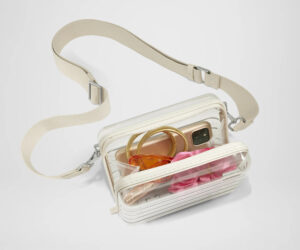Introduction
Camera bags are more than just a tool for photographers—they’re a blend of functionality and style. Once designed solely to protect expensive gear, they’ve evolved into versatile accessories that cater to both professionals and casual users.
Today, camera bags are not just practical; they’ve become a statement piece in the fashion world.
In this article, we’ll take a closer look at the history of camera bags, their key design features, and why they remain essential.
If you’re a bulk buyer, we’ll also share tips on what to look for, including material durability, cost-effectiveness, and customization options. Whether you need bags for resale or professional use, this guide has you covered. Let’s dive in!
Historical Origins of the Name
Early Camera Carrying Solutions (19th – Early 20th Century)
In the late 19th and early 20th centuries, cameras were bulky and fragile, necessitating specialized cases for protection.
These cases were often made of fitted leather, designed specifically for large-format cameras and the delicate glass plates they used. The snug, durable design ensured cameras could be transported safely, even in rough conditions.
By the 1880s, the “Ever-Ready” bag became a popular solution. Made from tough cowhide, these bags featured internal partitions that allowed photographers to carry not only their cameras but also additional plates and accessories.
This era set the foundation for what we now recognize as camera bags—functional, protective, and purpose-built.
The Transition to Modern Camera Bags (Late 20th Century)
The late 20th century marked a turning point. As photojournalism gained prominence in the 1960s, photographers began using smaller 35mm cameras, which called for compact and portable bags.
This shift led to the creation of more feature-rich designs, with compartments for lenses, film rolls, and personal items. Why Is It Called A Camera Bag
Brands like Billingham and Domke revolutionized the industry during this time. Drawing inspiration from fishing bags, they introduced lightweight, weatherproof designs with padded interiors.
These innovations laid the groundwork for today’s camera bags, balancing protection, practicality, and style.
The name “camera bag” reflects this evolution—a product born from necessity but shaped by decades of innovation and adaptation.
Design Features That Justify the Name
Size and Proportions
Camera bags are instantly recognizable for their thoughtful proportions. For compact cameras, the bags are often petite and boxy, perfectly sized to fit small devices without wasted space, snugly. This design allows for easy portability while keeping the gear secure.
For professional photographers, scalability becomes key. Modern camera bags are designed to accommodate larger setups, including multiple camera bodies, lenses, and accessories.
Adjustable compartments and expandable sections make it easy to adapt the bag to individual needs, whether for a quick photoshoot or a long-term project.
Specialized Compartments and Padding
One of the defining features of a camera bag is its internal organization. Unlike regular bags, camera bags include carefully designed dividers and compartments.
These sections keep lenses, batteries, memory cards, and cameras themselves neatly organized, making it easy to grab what you need on the go.
Padding is another crucial element. High-density foam or shock-absorbing materials line the interior of camera bags, offering protection against accidental drops or bumps.
For expensive and fragile gear, this padding is non-negotiable—it’s what gives the bag its real value.
These features aren’t just functional—they’re what make a camera bag a true extension of a photographer’s toolkit.
Every detail, from the size to the internal dividers, is purpose-built to protect and organize, ensuring that the name “camera bag” is more than just a label—it’s a promise.
The Name’s Persistence in the Fashion World
Camera Bags as Fashion Statements
What started as a purely functional accessory has now become a major fashion trend. Luxury brands like Gucci, Prada, and Louis Vuitton have embraced the traditional camera bag shape, reimagining it with premium materials and designer aesthetics.
These “designer camera bags” are no longer just for photographers—they’re chic, versatile accessories that elevate any outfit.
Social media and street style have also played a huge role in popularizing camera bags.
Influencers and fashion enthusiasts showcase these compact, structured designs as must-have items, blending practicality with a polished look. The camera bag name, once tied to photography, now carries a stylish allure in the fashion world.
Function Meets Fashion
Despite their evolution into fashion statements, camera bags haven’t lost their practicality. Many designer versions retain functional features like spacious interiors, adjustable straps, and durable materials. This makes them ideal for modern consumers who want both style and utility in their everyday bags.
Interestingly, the influence of camera bag design has extended into broader fashion trends. Features like internal compartments, padded sections, and boxy silhouettes are now common in regular handbags and crossbody designs. This fusion of practicality and style ensures that the “camera bag” name continues to resonate, bridging the gap between utility and elegance.
Types of Camera Bags and Their Naming Connotations
Shoulder (Messenger) Camera Bags
Shoulder camera bags, often called messenger camera bags, are designed with quick access in mind. Their single-strap design allows photographers to swing the bag forward, grab their gear, and get the shot without missing a beat.
This practical feature has made them a favorite among photojournalists and event photographers who need to stay mobile.
These bags are also incredibly versatile. Their sleek design and compact size make them ideal for casual outings, professional shoots, or even as an everyday carry bag.
The name “messenger” reflects their easy-carry functionality, while retaining the core purpose of a camera bag: convenience and protection.
Backpack Camera Bags
Backpack camera bags are all about comfort and capacity. With two shoulder straps for balanced weight distribution, they’re perfect for carrying heavier gear over long periods.
This makes them a go-to choice for outdoor photographers, hikers, and travelers who need to pack cameras, lenses, tripods, and personal items in one bag.
Many backpack camera bags also include specialized features like waterproof materials,, hidden zippers for security, and compartments for laptops or hydration packs.
These features make them versatile for both photography and general travel, further solidifying their reputation as the ultimate on-the-go solution.
Sling Camera Bags
Sling camera bags are built for mobility. With a single strap worn diagonally across the body, these bags are compact and easy to maneuver.
They’re particularly popular among street photographers who need a lightweight option to carry just the essentials, like a mirrorless camera, a lens, and a few accessories.
The name “sling” reflects their casual, hands-free design, making them perfect for busy urban environments. Their compactness and easy access allow photographers to move quickly and capture moments on the fly, blending functionality with a modern, minimalist appeal.
Each type of camera bag carries a name and design that reflects its purpose, ensuring photographers have the right tool for every situation.
Why Partner with Pecbag for OEM/ODM Custom Belt Bags and Pouches?
For bulk buyers seeking high-quality, customizable camera bags and pouches, Pecbag provides unmatched advantages through its OEM and ODM services.
Whether you’re looking to launch a new product line or expand your existing offerings, Pecbag ensures your needs are met with precision and professionalism.
Expertise in Customization
Pecbag specializes in tailoring camera bags to your exact requirements. From branding options like logos and labels to material selection, color palettes, and unique features, every detail can be customized to reflect your brand’s identity.
This flexibility allows you to stand out in a competitive market with products that truly resonate with your customers.
High-Quality Manufacturing
Quality is at the heart of Pecbag’s manufacturing process. Using advanced craftsmanship and durable materials, Pecbag ensures that every bag meets the highest standards of functionality and longevity. Whether it’s reinforced stitching, waterproof fabrics, or precision padding, the products are built to last.
Competitive Pricing for Bulk Orders
Scaling your business doesn’t have to break the bank. Pecbag offers cost-effective solutions for bulk orders without compromising on quality. This makes it an ideal partner for businesses looking to maximize profitability while delivering top-tier products to their customers.
Sustainability Options
Modern consumers value eco-friendly practices, and Pecbag helps you meet that demand. With options for sustainable materials and packaging, you can reduce your environmental footprint and appeal to eco-conscious buyers. It’s a win-win for your business and the planet.
Reliable Partnership and After-Sales Support
Pecbag isn’t just a supplier—it’s a partner you can trust. Dedicated account managers guide you through every step, from product design to delivery. Plus, their post-delivery support ensures smooth operations, addressing any concerns promptly and professionally.
Partnering with Pecbag means gaining a reliable ally in creating custom camera bags and pouches that combine quality, innovation, and cost-efficiency. Whether you’re a wholesaler, retailer, or online seller, Pecbag has the expertise to help your business thrive.
Conclusion
Recap of the Naming Origins
The term “camera bag” has its roots in functionality and practicality. From the snug, fitted leather cases of the 19th century to the versatile and stylish designs of today, the evolution of camera bags reflects the changing needs of photographers.
The name itself speaks to the original purpose of these bags: to protect and carry precious camera equipment efficiently and securely.
The Enduring Significance of Camera Bags
Camera bags remain indispensable for photographers, offering organization, protection, and portability for their gear. Beyond their utility, these bags have evolved into fashion-forward accessories, blending style with practicality.
Whether used by professionals or incorporated into everyday streetwear, camera bags have cemented their place as both functional tools and stylish staples.
Future Trends in Camera Bag Design and Naming
The future of camera bags promises exciting innovations and adaptations, including:
- Customization Opportunities for Bulk Buyers
Businesses have increasing opportunities to offer tailored camera bags with unique branding, material options, and specialized features. This level of personalization allows brands to cater to niche markets and stand out. - Technological Integrations
Smart features are becoming more common, with possibilities like built-in GPS tracking, wireless charging for devices, and anti-theft mechanisms. These advancements enhance usability and appeal to tech-savvy consumers. - Sustainable Design
With growing environmental awareness, the use of eco-friendly materials and sustainable production methods is on the rise. These designs not only reduce environmental impact but also resonate with consumers who value green initiatives.
In summary, the camera bag is more than just a practical accessory—it’s a reflection of evolving technology, fashion trends, and consumer values.
Whether you’re a photographer, a fashion enthusiast, or a bulk buyer looking to innovate, camera bags continue to offer versatility, functionality, and style for every need.









